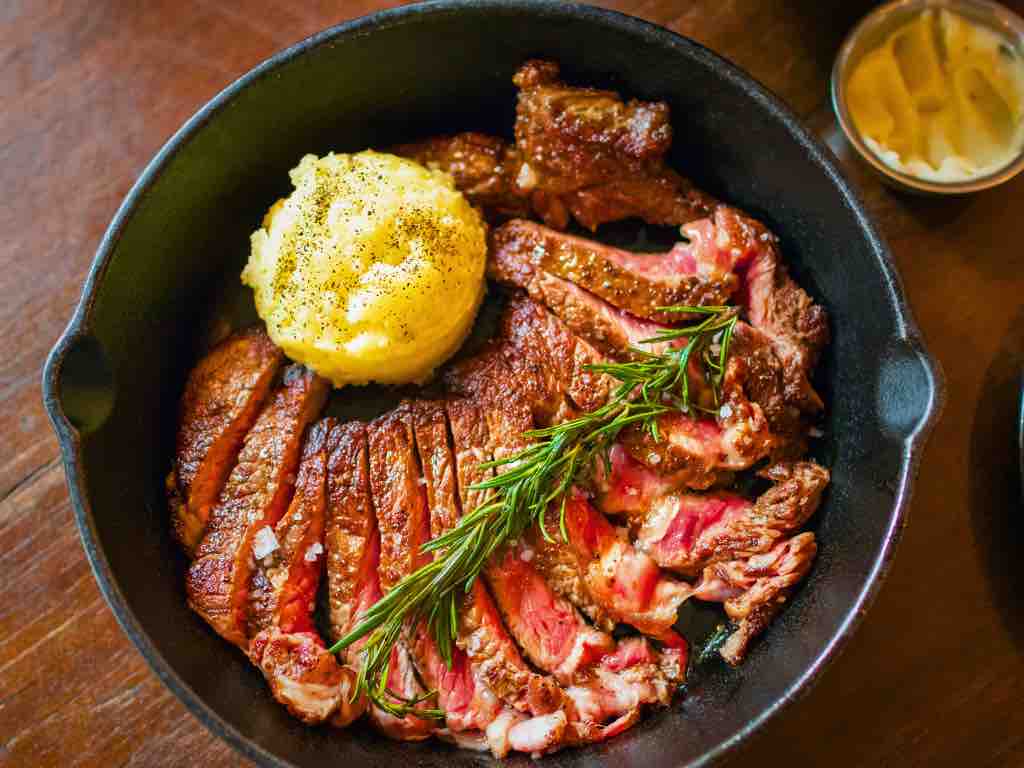
Cast Iron Ribeye Steak: A Flavorful and Juicy Delight
|
|
Time to read 10 min
Welcome to One Stop Halal!
Written by: Samir P.
|
|
Time to read 10 min
Cooking a ribeye steak in a cast iron skillet is a time-tested method that guarantees a flavorful and juicy result. The sizzling heat of the cast iron creates a delicious crust on the steak while sealing in the natural juices. In this blog, we will explore the step-by-step process of cooking a mouthwatering cast iron ribeye steak. From selecting the right cut to achieving the perfect sear, we'll cover everything you need to know to make a restaurant-quality steak in the comfort of your own kitchen. Get ready to impress your family and friends with this simple yet impressive cooking technique.
Ribeye steak is a highly prized and flavorful beef cut known for its marbling, tenderness, and rich taste. It comes from the cow's rib section, specifically from the rib primal cut. This animal area is well-exercised, contributing to the steak's robust flavor.
Ribeye steak is characterized by its abundant intramuscular fat, known as marbling, which melts during cooking and adds a luxurious juiciness to the meat. The marbling also enhances the flavor and provides a succulent buttery texture.
This steak is often boneless, although some variations may include a small section of the rib bone, which adds to the overall flavor profile. The cut typically has a good balance of meat and fat, making it incredibly flavorful and tender.
When selecting ribeye steak, look for vibrant red color, well-distributed marbling, and a thick, even cut. The quality and grade of the steak, such as USDA Prime or Choice, can also impact its taste and tenderness.
Whether you cast iron ribeye steak or cook using other methods, understanding its characteristics will help you appreciate and enjoy this delicious and popular cut of beef.
Cooking ribeye steak in a cast iron skillet offers several advantages that contribute to a mouthwatering and memorable dining experience. Here are some key benefits:
With cast iron ribeye steak, you can harness these benefits and create a succulent, flavorful steak that will delight your taste buds and impress your guests.
Choosing the right ribeye steak is essential to ensure a delicious and enjoyable dining experience. Here are some tips for selecting the perfect ribeye steak:
For cast iron ribeye steak, consider the factors that meet your expectations for flavor, tenderness, and overall dining satisfaction.
Welcome to your favorite butcher shop. We carry custom cuts of beef, chicken, lamb, goat, grass-fed beef, wagyu, deli, and more. We ship across the United States in 1-2 business days.
Properly preparing the ribeye steak sets the foundation for a delicious and satisfying culinary experience. Here are key steps to follow when preparing your ribeye steak:
For cast iron ribeye steak, following these steps, you'll ensure that your ribeye steak is well-prepared and ready for cooking, setting the stage for a delicious and enjoyable meal.
Properly preheating your cast iron skillet is a crucial step when cooking ribeye steak. Here's how to preheat your cast iron skillet for optimal results:
For cast iron ribeye steak, properly preheating the skillet ensures that the steak cooks evenly and develops a desirable sear. This step is crucial for achieving that delicious crust and preserving the juiciness of the ribeye steak.
Searing the ribeye steak is a key step in cooking that helps develop a flavorful crust on the outside while locking in the juices. Here's how to achieve a perfect sear:
For cast iron ribeye steak, following these steps, you'll achieve a beautifully seared ribeye steak with a flavorful crust that adds depth and enhances the overall dining experience.
Welcome to the Home of the Beef Cuts. We deliver to your doorstep anywhere in the United States within 1-2 business days. We carry custom cuts of beef, which are hard to find in your nearby specialty butcher shops.
Cooking a ribeye steak to the desired level of doneness is essential for creating a satisfying eating experience. Here are some guidelines to help you achieve the perfect doneness:
Remember that the temperatures mentioned are guidelines for cast iron ribeye steak, and personal preferences may vary. It's best to use a meat thermometer to ensure the ribeye steak reaches your desired level of doneness.
Resting the ribeye steak after cooking is a crucial step to ensure optimal juiciness and tenderness. Here's why resting is important and how to slice the steak:
By allowing the steak to rest and then slicing it properly, you'll enjoy a juicy and tender cast iron ribeye steak that is full of flavor.
While a perfectly cooked ribeye steak is delicious on its own, you can enhance its flavors further with various additions and sauces. Here are some flavor-enhancing options to consider:
Experiment with different sauces, marinades, or rubs to find the perfect flavor combination for your cast iron ribeye steak. The right sauce can elevate the taste and add a layer of deliciousness to your meal.
To ensure a successful ribeye steak cooking experience, keep the following tips in mind and avoid these common mistakes:
By following these tips and avoiding common mistakes such as overcooking or improper seasoning, you'll be on your way to a delicious and perfectly cooked cast iron ribeye steak.
Mastering the art of cooking a cast iron ribeye steak will elevate your culinary skills and impress your taste buds. By following the steps outlined in this blog, you can savor a juicy, tender, and flavorful steak that rivals any steakhouse. Experiment with different seasonings, sauces, and sides to create your perfect cast iron ribeye experience. With some practice and attention to detail, you'll become a pro at perfectly cooking this classic steak. Get ready to indulge in a culinary delight that will bring you back for more!

© 2025 One Stop Halal, Inc.